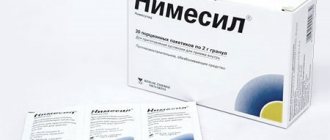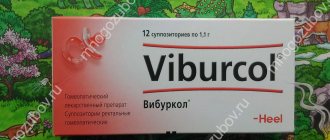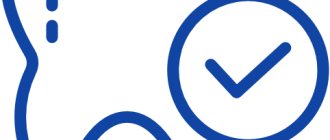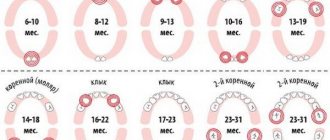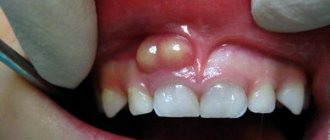Teething in a child is one of the important stages of its development. Milk teeth not only allow you to gradually switch from liquid to solid food, but also indicate the baby’s health status.
Despite the fact that this process is physiological, the period of teething often causes discomfort to the child and causes a lot of anxiety and worry in parents. What should young mothers be prepared for at this time? Let's explain everything in order.
Children, when teething, pull their toys into their mouths; the desire to chew something alleviates the unpleasant sensations.
When does a child start teething - table
From 4 to 7 months is the age when most children develop their first teeth. The sequence of their eruption is visible from the table.
| Name of teeth | Period of eruption, months. | |
| 1. | Incisors (central and lateral) | 4-12 |
| 2. | First molars | 12-19 |
| 3. | Fangs | 18-24 |
| 4. | Second molars | 24-32 |
The appearance of all 20 baby teeth occurs by the age of 3. But this process is individual, so small deviations in one direction or another should not cause anxiety in parents. If you are still concerned about early or late teething, then check this point with your pediatrician.
Factors influencing the timing of eruption:
- the nutritional pattern of the expectant mother;
- water quality;
- baby food ration;
- climatic living conditions;
- heredity.
There is usually nothing wrong with teething. But still, most children at this time experience discomfort and become restless.
Paracetamol and ibuprofen: compare the composition of the drugs
Panadol and Nurofen belong to the same pharmacological group - non-steroidal anti-inflammatory drugs (NSAIDs). From the name it is clear that they are used where it is necessary to relieve inflammation and its main symptoms: pain, heat, swelling. Details about each medicine are in the table.
| A drug | Panadol | Nurofen |
| Active substance | Paracetamol | Ibuprofen |
| Release form | Film-coated tablets, oral suspension, rectal suppositories | Film-coated tablets, capsules, oral suspension, gel for external use, rectal suppositories |
| Vacation at the pharmacy | Over the counter | Over the counter |
| Manufacturer | GlaxoSmithKline Sante Grand Public (France) | Reckitt Benckiser Healthcare International Ltd. (Great Britain) |
| Price | 50-100 rubles | 100-300 rubles |
The main symptoms that occur during teething
During the period when a child is teething, the following is most often observed:
- increased salivation;
- swelling, redness, soreness of the gums;
- irritability;
- sleep disturbance;
- poor appetite;
- need for chewing, biting, sucking.
Rarer symptoms include:
- temperature rise to 380;
- diarrhea;
- rhinitis;
- nausea and/or vomiting.
According to research by scientists from the Federal State Budgetary Educational Institution of Further Professional Education RMANPE of the Ministry of Health of Russia, certain symptoms occur in 60-70% of children. And only 30-40% do not experience any unpleasant manifestations. The symptoms listed above are more pronounced in infants who had low birth weight.
The study authors also concluded that in most cases, fever, runny nose, and diarrhea are not associated with the process of teeth emerging, but with manifestations of infection. If the pediatrician determines that the child’s condition is caused by teething, parents have no particular reason to worry. You just need to help the baby get through this difficult period.
Let's evaluate the effectiveness of the drugs
In the medical community, they repeatedly try to compare two popular NSAIDs - ibuprofen and paracetamol. The DOVER study conducted in 2006 in the UK deserves special attention. This is a multicenter, randomized, double-blind, placebo-controlled study examining the effectiveness and safety of antipyretics in children. The authors found that both drugs effectively reduce body temperature. However, in the presence of pain (for example, during teething), parents preferred to use ibuprofen as a more effective remedy.
The researchers concluded that ibuprofen is the drug of choice for short-term treatment for pain of moderate intensity, as well as for a combination of fever and pain. Paracetamol can also be used, but its analgesic effect is lower even at the maximum dosage of 915 mg per 1 kg of body weight).
The medical literature has not ignored the combined use of drugs. A review of scientific articles shows: paracetamol enhances the therapeutic effect of ibuprofen by 64%. Combined products relieve pain 15 minutes after use and last up to 9 hours. Studies have shown that this combination is especially effective in the treatment of osteoarthritis and other diseases of the musculoskeletal system.
There are many randomized studies devoted to ibuprofen and paracetamol. The Cochrane Library contains several reviews covering the effects of these drugs. There is no doubt about their effectiveness:
- Nurofen quickly relieves pain in the postoperative period. It is used in rheumatology and orthopedics for inflammatory joint diseases, and in neurology for migraines and other headaches. Ibuprofen has shown itself well in the fight against the symptoms of diseases of the musculoskeletal system. It also relieves fever from colds and flu.
- Panadol is prescribed in the postoperative period - it eliminates pain 15 minutes after application. But the drug does not always help with pain due to inflammation - for example, with osteoarthritis. In neurology, paracetamol is prescribed for migraines, but does not eliminate tension headaches. Copes well with cold symptoms.
General recommendations
As a rule, the teething period takes from 2 days to a week. And at this time, parents should be especially patient and affectionate towards the child. The best way to distract your baby is to try to redirect his attention.
It is necessary to pay enough attention to the child in order to distract him from pain and discomfort during teething.
You need to pick him up more often, offer him interesting toys, take walks (if the child feels normal). Now, during the quarantine period, try to ventilate the room as often as possible and go out to the balcony with your child. When walking, it is better to avoid crowded places and try to limit visits to the houses of strangers.
Babies who are breastfed are more likely to ask for the breast at this time. There is no need to refuse a child, as this calms him down. It is also not recommended to change the feeding regimen and introduce new types of complementary foods.
Many children put their toys in their mouths when teething begins. Therefore, it is necessary to monitor their cleanliness. The desire to chew something relieves discomfort. You can give the baby a special rubber ring, after thoroughly treating it with a soda-soap solution and keeping it in the refrigerator for some time to cool. Many kids willingly nibble on crackers, biscuits or cookies.
How do they work
All non-steroidal anti-inflammatory drugs act according to the same scheme - they prevent the production of inflammatory mediators. They affect the synthesis of cyclooxygenase (COX), which is presented in three variants in the human body:
- COX-1 is constantly produced and participates in metabolic processes.
- COX-2 is synthesized only during inflammation.
- COX-3 is also produced during pain and fever, but does not affect the development of inflammation.
- NSAIDs inhibit the production of COX and have the following effect:
- antipyretic – reduces high body temperature;
- analgesic – relieve pain;
- anti-inflammatory – suppress the activity of the inflammatory process.
The difference lies only in the nuances of the action of NSAIDs. Let's take a closer look at each drug.
Nurofen
Ibuprofen is a non-selective cyclooxygenase inhibitor. It inhibits the synthesis of two enzymes at once - COX-1 and COX-2. This explains the high frequency of adverse reactions: ibuprofen not only relieves fever and pain, but also affects the functioning of internal organs.
The drug quickly enters the bloodstream when taken orally or through the rectum, reaching a maximum after 45 minutes. Valid for up to 8 hours. It undergoes transformation in the liver and is excreted in bile and urine.
Panadol
Paracetamol is a mysterious drug. The mechanism of its action has not yet been studied. Scientists have found no evidence that it affects the synthesis of COX-1 or COX-2. Some experts believe that paracetamol still binds to cyclooxygenases, but not in the part of the molecule where other NSAIDs do. It is not clear how, but this drug works - it relieves pain and lowers body temperature.
A review of the medical literature provides us with another possibility: the effect on COX-3. Many scientists suggest that paracetamol inhibits the synthesis of this enzyme and thereby reduces body temperature. But since COX-3 does not affect the course of the inflammatory process, paracetamol is a poor analgesic. It does not suppress the development of inflammation and pain, therefore it is used mainly only as an antipyretic.
The theory of COX-3 inhibition has been criticized in the scientific community. Scientists have not yet been able to isolate this enzyme in human tissue. So far, COX-3 has only been found in the tissues of experimental animals. Its existence in the human body has not been proven.
Paracetamol is rapidly absorbed and reaches a maximum after 30 minutes. The effect lasts up to 4-6 hours. Excreted through the kidneys.
Indications and application regimen
Panadol is primarily an antipyretic drug. It is prescribed for those who need to reduce high body temperature. It practically does not relieve pain and does not affect other parts of the inflammatory process. Although the instructions for use indicate pain as one of the indications, practicing doctors rarely prescribe this remedy for dental, joint and muscle pain.
Nurofen is a drug that has a pronounced analgesic and antipyretic effect. It is used in the following situations:
- high body temperature with influenza, ARVI and other diseases;
- headache;
- toothache;
- neuralgia;
- muscle and joint pain;
- painful menstruation in women;
- pain in the postoperative period.
The regimen of use depends on the form of release of the drug. The medicine in the form of a suspension is usually used in pediatric practice - from birth. Children are also prescribed rectal suppositories - into the rectum. Tablets and capsules are offered to children from 12 years of age and adults. The gel is used only for external use - for example, for pain in mice and joints.
The dosage and frequency of administration of the drug are calculated based on the patient’s age and weight. It is important to strictly adhere to the chosen dosage and interval between taking the medication. An overdose is dangerous and can lead to serious complications and even death.
Let's consider the scheme of using NSAIDs in adults:
- Panadol is prescribed in a dosage of 500-1000 mg at a time, no more than 4 times a day with an interval of at least 4 hours. The maximum daily dose is 4 g.
- Nurofen is prescribed 200-400 mg 3-4 times a day with an interval of at least 6 hours. The maximum daily dose is 1200 mg.
As antipyretics, Nurofen and Panadol can be used together, but not simultaneously. First, the patient takes one drug, after 3-4 hours, if the effect decreases, a second one. This scheme reduces the frequency of use of each drug and the risk of adverse reactions.
Paracetamol and ibuprofen are included in the World Health Organization Model List of Essential Medicines and are recommended for use in pediatric practice.
Price
This factor is very important. In many cases, for people interested in whether Panadol or Nurofen is better for children, price is the determining criterion. The cost of various forms of release is presented in the table below.
| Release form | Price | |
| "Nurofen" | "Panadol" | |
| Pills | 120 rub. | 50 rub. |
| Suppositories | 110 rub. | 70 rub. |
| Suspension, 100 ml | 150 rub. | 100 rub. |
| Suspension, 150 ml | 220 rub. | Not produced in this volume |
| Suspension, 200 ml | 280 rub. | Not produced in this volume |
Based on the data in the table, we can conclude that Nurofen is a more expensive drug.
"Nurofen": pharmacological action
The active component of the drug is ibuprofen. This is a non-hormonal substance that has powerful anti-inflammatory and analgesic properties. In addition, while taking it, body temperature normalizes. The maximum effect is achieved in the presence of painful sensations of an inflammatory nature.
Ibuprofen, penetrating the body, inhibits the development of the infectious process. This occurs due to the fact that the active component inhibits the synthesis of substances that increase the severity of inflammation. In addition, according to numerous clinical studies, ibuprofen is directly involved in the production of interferon, a powerful immunomodulator. This fact can be decisive for parents who do not know which is better - children's Nurofen or Panadol.
It is worth noting that the drug also contains domiphene bromide. It is an antiseptic with an antifungal effect. It is intended to enhance the overall anti-inflammatory effect.
Side effects
The annotation for Nurofen states that the risk of developing undesirable consequences can be minimized if you take the drug for the shortest possible course. Moreover, the higher the dosage, the higher the risk of side effects.
In isolated cases, the following diseases and conditions may develop during treatment:
- Disorders of the hematopoietic system, manifested by bruising of an unknown nature.
- Dyspnea.
- Bronchospasm.
- Skin reactions (rashes, itching, burning, etc.).
- Allergic rhinitis.
- Severe hypersensitivity reactions (anaphylactic shock, Quincke's edema).
- Nausea.
- Painful sensations in the stomach area.
- Flatulence.
- Constipation or, on the contrary, diarrhea.
- Gastritis.
- Ulcerative stomatitis.
- Kidney failure.
- Headache.
- Peripheral edema.
- Increased blood pressure.
If any of these conditions occur, treatment with this drug should be completed and you should consult a doctor.
Possible side effects of Panadol:
- Nausea, sometimes turning into vomiting.
- Painful sensations in the stomach area.
- Hives.
- Skin itching.
- Quincke's edema.
- Anemia.
So, if we take the risk of side effects as a basis, which is better for children - Nurofen or Panadol? The first has an impressive list of possible adverse reactions. Panadol wins in this case.
Pediatricians' opinions
According to WHO, ibuprofen and drugs based on it are the second choice. Paracetamol has been in first place for many years.
Parents interested in whether Nurofen or Panadol are better for children should know that the former is effective for inflammatory pain. A drug based on paracetamol is safer and more effective for colds and teething. In both cases, the therapeutic effect lasts for an average of 6 hours.
Action of Panadol
The active component of the drug is paracetamol. The latter has been considered the safest antipyretic and analgesic for children for several decades, which is especially important for children suffering from gastrointestinal pathologies. This is due to the fact that paracetamol does not have a negative effect on the mucous membranes of the digestive system. In addition, during treatment, water-salt metabolism is not disturbed.
Thus, if a child suffers from diseases of the gastrointestinal tract, the question of which is better - Nurofen or Panadol - disappears.
It is important to consider that both drugs lower body temperature and relieve pain. But only Nurofen has an anti-inflammatory effect.

